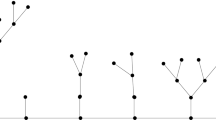Abstract
A mathematical model for distribution of mass ind-dimensional space, based upon randomly embedding random trees into space, is introduced and studied. The model is a variant of thesuper Brownian motion process studied by mathematicians. We present calculations relating to (i) the distribution of position of a typical mass element, (ii) moments of the center of mass, (iii) large-deviation behavior, and (iv) a recursive self-similarity property.
Similar content being viewed by others
References
D. J. Aldous, A random tree model associated with random graphs,Random Structures Algorithms 1:383–402 (1990).
D. J. Aldous, The continuum random tree II: An overview, inStochastic Analysis, M. T. Barlow and N. H. Bingham, eds.(Cambridge University Press, Cambridge, 1991), pp. 23–70.
D. J. Aldous, The continuum random tree III,Ann. Prob. 21:248–289 (1993).
D. J. Aldous, Recursive self-similarity for random trees, random triangulations and Brownian excursion,Ann. Prob., to appear (1993).
N. A. C. Cressie,Statistics for Spatial Data (Wiley, 1991).
D. A. Dawson, I. Iscoe, and E. A. Perkins, Super-Brownian motion: Path properties and hitting probabilities,Prob. Theory Related Fields 83:1235–205 (1989).
D. A. Dawson and E. Perkins, Historical processes,Mem. Am. Math. Soc. 93(454) (1991).
A. Dembo and O. Zeitouni,Large Deviations and Applications (Jones and Bartlett, Boston, 1992).
E. B. Dynkin, Representation for functionals of superprocesses by multiple stochastic integrals, with applications to self-intersection local times, inColloque Paul Levy sur les Processes Stochastiques, Asterisque 157-158:147–171 (1988).
E. B. Dynkin, Branching particle systems and superprocesses,Ann. Prob. 19:1157–1194 (1991).
E. B. Dynkin, Path processes and historical superprocesses,Prob. Theory Related Fields 90:1–36 (1991).
E. B. Dynkin, A probabilistic approach to one class of nonlinear differential equations,Prob. Theory Related Fields 89:89–115 (1991).
S. N. Evans and E. Perkins, Measure-valued Markov branching processes conditioned on non-extinction,Israel J. Math. 71:329–337 (1990).
T. S. Ferguson, Prior distributions on spaces of probability measures,Ann. Stat. 2:615–629 (1974).
J.-F. Le Gall, Brownian excursions, trees and measure-valued branching processes,Ann. Prob. 19:1399–1439 (1991).
J.-F. Le Gall, The uniform random tree in a Brownian excursion,Prob. Theory Related Fields 96:369–384 (1993).
S. Graf, R. D. Mauldin, and S. C. Williams, The exact Hausdorff dimension in random recursive constructions,Mem. Am. Math. Soc. 71(381):1–121 (1988).
D. A. Griffin,Advanced Spatial Statistics (Kluwer, 1988).
T. Hara and G. Slade, Critical behavior of self-avoiding walk in five or more dimensions,Bull. Am. Math. Soc. 25:417–423 (1991).
T. Hara and G. Slade, The number and size of branched polymers in high dimensions,J. Stat. Phys. 67:1009–1038 (1992).
T. Hara and G. Slade, On the upper critical dimension of lattice trees and lattice animals.J. Stat. Phys. 59:1469–1510 (1990).
I. Iscoe, Ergodic theory and a local occupation time for measure-valued critical branching Brownian motion,Stochastics 18:197–243 (1986).
I. Iscoe, A weighted occupation time for a class of measure-valued branching processes,Prob. Theory Related Fields 71:85–116 (1986).
W. Lavine, Some aspects of Polya tree distributions for statistical modelling,Ann. Stat. 20:1222–1235 (1992).
N. Madras and G. Slade,The Self-Avoiding Walk (Birkhauser, 1992).
R. D. Mauldin, W. D. Sudderth, and S. C. Williams, Polya trees and random distributions,Ann. Stat. 20:1203–1221 (1992).
E. Perkins, Polar sets and multiple points for super-Brownian motion,Ann. Prob. 18:453–491 (1990).
B. W. Silverman,Density Estimation for Statistics and Data Analysis (Chapman and Hall, 1986).
H. E. Stanley and N. Ostrowsky, eds.,On Growth and Form: Fractal and Non-Fractal Patterns in Physics (NATO ASI Series E, Applied Science No. 100, Nijhoff, Dordrecht, 1986).
T. Vicsek,Fractal Growth Phenomena, 2nd ed. (World Scientific, Singapore, 1992).
Author information
Authors and Affiliations
Rights and permissions
About this article
Cite this article
Aldous, D. Tree-based models for random distribution of mass. J Stat Phys 73, 625–641 (1993). https://doi.org/10.1007/BF01054343
Received:
Issue Date:
DOI: https://doi.org/10.1007/BF01054343




